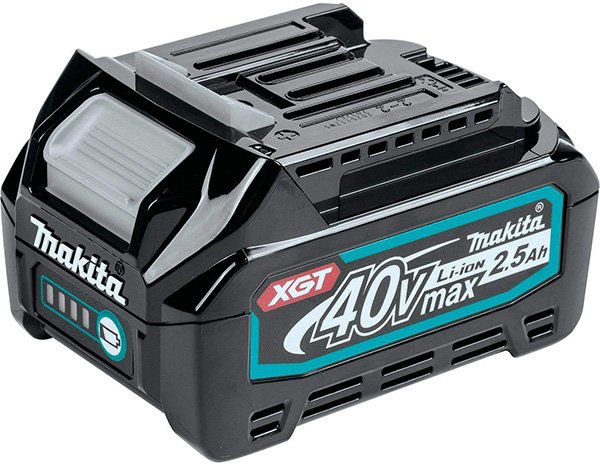
If you buy something through our links, ToolGuyd might earn an affiliate commission.
I want to make sure everyone understands the fundamentals behind the new Makita XGT 40V Max cordless power tool batteries.
Shown above is Makita’s new 40V Max XGT 2.5Ah battery.

Shown here is Makita’s 18V 5Ah battery.
Both batteries have (10) 18650-sized cells. Makita has said that their 2.5Ah battery has the same 18V form factor as their 18V batteries, which leads us to presume about the cell sizing until some of the more explorative users start posting teardowns.
So, Makita 18V LXT 5.0Ah and 40V Max XGT 2.5Ah batteries both feature the same number of batteries, and the same size of batteries. This will not be true for Makita’s XGT 4.0Ah and 5.0Ah batteries.
Li-ion Battery Cells
Each Lithium-ion cell outputs a 3.6V nominal voltage. Sometimes the number is 3.7V, but we consider it to be 3.6V universally for convenience.
Battery Cells in Series
Let’s say you have 5 batteries and line them up in series. The voltage is additive, and you will have a nominal voltage of 18V.
When you arrange Li-ion battery cells in series, you multiply their voltage.
Thus, when you have (10) Li-ion cells in series, you create a 10 x 3.6V – 36V battery. Makita describes their XGT system as being 40V Max, but it’s really a 36V system in the same way 20V Max tools operate at 18V nominally. If each cell connected in series is rated with 2.5Ah of charge capacity, that’s what the final charge capacity of the battery pack will be.
With any cordless power tool system described as some “Max” voltage, the Max part refers to the fact that this is the maximum right-off-the-charger voltage even before any load is applied. In other words, the max voltage is the voltage as measured before the battery does any work. The nominal voltage is a more accurate measure of the operation voltage.
Battery Cells in Parallel
Let’s say that you took 5 Li-ion batteries and instead lined them up in parallel. The voltage would still be the same 3.6V as a single cell, but you would not have 5 times the charge capacity.
When you arrange Li-ion battery cells in parallel, you multiply their charge capacity.
Put it Together
In the Makita XGT 40V Max 2.5Ah battery, you have (10) 2.5Ah cells connected together in series.
Now, take those same 10 cells and configure them differently – with 2 rows of 5 cells. The cells are paired together in parallel and then arranged in series. You now have a 5S-2P configuration.
Each cell has the same 3.6V nominal voltage and 2.5Ah charge capacity as the cells in the 40V Max pack. In this 5S-2P configuration, the final battery pack properties are as follows: 5 x 3.6V = 18V and 2 x 2.5Ah = 5.0Ah.
Thus, with the same (10) 2.5Ah Li-ion cells, you have built a 36V/40V Max battery pack with 2.5Ah charge capacity, or an 18V/20V Max battery with 5.0Ah charge capacity.
Watt-Hours
Watt-hours is a unit of measurement for power over a period of time – it’s a measure of energy.
Consider the Makita XGT 40V Max 2.5Ah battery: 36V x 2.5Ah = 90 watt-hours.
Now consider the energy stored in an 18V battery pack where the same cells are connected in a 5S-2P configuration: 18V x 5.0Ah = 90 watt-hours.
In other words, the energy is the same.
Makita XGT: Why 40V Max?
Makita’s 18V LXT has reached a sort of technological ceiling as far as battery technologies go. While other cordless power tool brands have come out with next-gen battery packs, Makita has not.
However, that will not be the case for their XGT 40V Max lineup.
The 2.5Ah battery shown here is so far the smallest battery pack Makita will offer, with a higher capacity 4.0Ah battery also available at launch.

Makita also has an XGT 5.0Ah battery said to be coming soon. Readers have pointed out that the XGT 40V Max 5.0Ah battery has a larger form factor than both of the other XGT battery packs, with the higher charge capacity of the 5.0Ah battery being attributed to a greater count of battery cells.
Comparing battery pack charge capacities or watt-hour ratings gets complicated once some of the variables start changing, such as if one battery has a greater number of cells, or physically larger-sized Li-ion cells. When the number or size of battery cells are different, this can lead to differences in power deliver and cooling capabilities, making comparisons difficult or even misleading.
Makita’s 40V Max XGT cordless power tool batteries, at least the 2.5Ah and 4.0Ah models, are the same sizes as many leading 18V and 20V Max cordless power tool batteries. This is because they are built using the same number and similar sizes of lithium-ion cells, with the main difference being in how those cells are connected together.
The Benefits of a Higher Voltage Cordless Power Tool Battery
In theory, higher voltage power sources are more energy-efficient than lower voltage sources, since they can deliver the same power with less current flow. Voltage and current are proportional to each other. If a device requires 10 watts (1 watt = 1 volt x 1 amp), you can achieve that with a 10V power source delivering 1A of current, a 5V power source delivering 2A of current, or a 20V power source delivering 0.5A of current.
In practice, leading power tool brands, such as Milwaukee Tool, have worked to minimize efficiency differences.
When you’re talking about 10 Li-ion cells arranged in a 36V/40V Max battery configuration compared to an 18V battery configuration, marketing differentiation is going to be one of the biggest benefits.
Makita could have come out with a new 18V or 20V Max cordless power tool system, but there are benefits to a higher voltage system. Plus, with XGT being a 40V Max and 80V Max (40V Max X2) system, there’s much less chance of confusion among users.
As the new 40V Max cordless tools and batteries are not at all cross-compatible with Makita’s 18V system, the differentiated branding helps to avoid the potential for user confusion.
There’s also a competitive advantage. If you see an 18V tool on the shelf, and a 40V Max tool on the same shelf and without much difference in size or features, which are you going to assume is the better tool?
Doubling up to 72V/80V Max does make things easier though when engineering higher power tools or certain devices.
There are likely going to be some practical benefits with Makita XGT being a higher-voltage system, but the differences compared to 18V are unlikely to be as significant as the numbers alone would suggest. Watt-hours tends to provide a fairer comparison, but also keep in mind what I said about additional variables – namely the number and size of the Li-ion cells – can skew things.
Here is additional reading on cordless power tool battery technologies:
Any questions?






